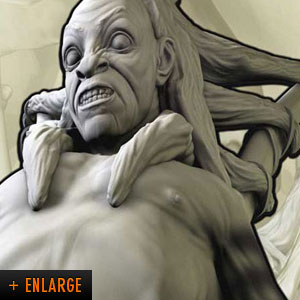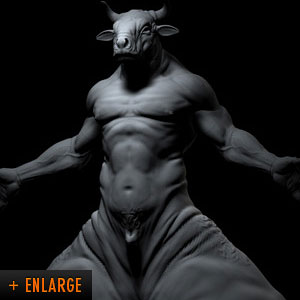
Model Supervisor for "Sky Captain and the World of Tomorrow
Tell us a little bit about yourself.
I have a BFA from The Cleveland Institute of Art with a major in sculpture, and a dual minor in drawing, and digital media. I was fortunate enough to spend time studying figure sculpture in Florence, and a few semesters at Case Western Reserve School of Medicine studying anatomy. I recently finished as the Model Supervisor on Sky Captain and the World of Tomorrow. I currently live in L.A. It is hot and crowded.
How did you first discover ZBrush?
Dave Cardwell, Son of Weta's Lord of the Rings legacy, and friend from The Cleveland Institute, introduced me to ZBrush and helped get the WOT modeling team involved with the Beta testing of Z2.
Which ZBrush techniques and applications have been useful to you in your work?
On Sky Captain and The World of Tomorrow, we used ZBrush to add detail through sculpting displacement maps for a variety of models including statues, terrain, digital doubles and creatures. Towards the end of production we were creating animated secondary creatures with less than 500 polys per mesh. If we needed a hero mesh for one of those creatures we could use ZBrush to export a more refined, higher-rez version of the same creature. This technique worked well when we needed meshes with enough information for skin and muscle deformation. We also used it to quickly create varying displacement maps to uniquely alter meshes.
For me, one of ZBrush's most useful attributes is its ability to utilize an understructure of organized geometry while letting the user make creative decisions. I think it was BB King, in regards to making good music, who said "First you gotta know your instrument, then you gotta know what kind of music you want to make, then you gotta forget all that and just jam." In many ways ZBrush lets you forget all the crap and just create.
"ZBrush lets you forget all the crap and just create"
What is your favorite new feature or features of ZBrush?
The ability to change forms on a macro level and have the micro details automatically conform was extremely beneficial. One example of how we utilized this technique was to quickly alter trees and vines to better fit the composition of each individual shot. By changing the geometry at a lower level, there was no need to re-sculpt the higher-level details such as, bark, knots, and mosses.
What were your reasons for using ZBrush?
I wanted to see if ZBrush could fit into our workflow because I had seen some impressive, if not intriguing, examples of sculptures created with it. In addition, there had been good feedback about it from other digital sculptors whose skills and opinions I respect. We ended up integrating it into our workflow, after a short amount of testing, because we knew it would add to the speed and creative freedom of our team.
"We needed software like ZBrush that could let
us quickly create the quantity and quality of
models necessary..."

Would you recommend ZBrush to other artists, and why?
Yes I would recommend it for production or personal use. I had a very small, and very talented team. There were five modelers in total, and approx. 1,800 entirely blue-screen shots. Because of our limited resources we needed software like ZBrush that could let us quickly create the quantity and quality of models necessary to fill those environments. It also gave us the ability to fluidly develop, and change designs as production dictated. In some ways ZBrush has the potential to bring about a new approach to digital modeling. It enables the user to quickly achieve finite, complex detail. When the ability to achieve these things becomes commonplace, it will cease to be a novelty that drives the design. Ideally, with these factors being so easy to achieve, the actual design and form of the sculpture will become the focus. Form and design elements are things I believe ZBrush is also useful in developing.
Do you plan to incorporate ZBrush in future projects?
Yes.
What other impressions or comments about ZBrush would you like to share with us?
The difference between ZBrush's previous versions and Z2 is kick-you-in-the face big. Z2 is an extremely useful software. After experiencing the Beta testing phase of Z2, and how quickly Pixologic's team was able to integrate requests, and desired functionality, it will be interesting to see what future versions hold.


